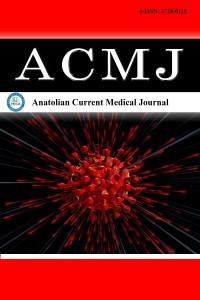The importance of urotensin II level in the diagnosis of acute mesenteric ischemia
The importance of urotensin II level in the diagnosis of acute mesenteric ischemia
Acute Mesenteric Ischemia, Urotensin-II, D-dimer,
___
- Acosta-Mérida MA, Marchena-Gómez J, Saavedra-Santana P, Silvestre-Rodríguez J, Artiles-Armas M, Callejón-Cara MM. Surgical outcomes in acute mesenteric ischemia: has anything changed over the years? World J Surg 2020; 44: 100–7.
- Van Noord D, Kolkman JJ. Functional testing in the diagnosis of chronic mesenteric ischemia. Best Pract Res Clin Gastroenterol 2017; 31: 59-68.
- Bourcier S, Oudjit A, Goudard G, et al. Diagnosis of non-occlusive acute mesenteric ischemia in the intensive care unit. Ann Intensive Care 2016; 6: 112.
- Clair DG, Beach JM. Mesenteric ischemia. N Engl J Med 2016; 374: 959–68.
- Rosenblum JD, Boyle CM, Schwartz LB. The mesenteric circulation. Anatomy and physiology. Surg Clin North Am 1997; 77: 289–306.
- Haglund U, Bergqvist D. Intestinal ischemia—the basics. Langenbeck’s Arch Surg 1999; 384: 233–8.
- Ross B, McKendy K, Giaid A. Role of urotensin II in health and disease. Am J Physiol 2010; 298: 1156–72.
- Mosenkis A, Kallem RR, Danoff TM, Aiyar N, Bazeley J, Townsend RR. Renal impairment, hypertension and plasma urotensin II. Nephrology Dialysis Transplantation 2011; 26: 609–14.
- Gardiner SM, March JE, Kemp PA, Davenport AP, Bennett T. Depressor and regionally-selective vasodilator effects of human and rat urotensin II in conscious rats. Br J Pharmacol 2001; 132: 1625–9.
- Bobadilla JL. Mesenteric ischemia. Surg Clin North Am 2013; 93: 925-40.
- Bourcier S, Oudjit A, Goudard G, et al. Diagnosis of non-occlusive acute mesenteric ischemia in the intensive care unit. Ann Intensive Care 2016; 6: 112.
- Kärkkäinen JM, Acosta S. Acute mesenteric ischemia (part I) - Incidence, etiologies, and how to improve early diagnosis. Best Pract Res Clin Gastroenterol 2017; 31: 15-25.
- Kozuch PL, Brandt LJ. Review article: diagnosis and management of mesenteric ischaemia with an emphasis on pharmacotherapy. Aliment Pharmacol Ther 2005; 21: 201-15.
- Kougias P, Lau D, El Sayed HF, Zhou W, Huynh TT, Lin PH. Determinants ofmortality and treatment outcome following surgical interventions for acutemesenteric ischemia. J Vasc Surg 2007; 46: 467–74.
- Nuzzo A, Maggiori L, Ronot M, et al. Predictive factors of intestinal necrosis in acute mesenteric ischemia: prospective study from an intestinal stroke center. Am J Gastroenterol 2017; 112: 597–605.
- Kulaçoğlu H, Kocaerkek Z, Moran M, Kulah B, Atay Ç, Kulaçoğlu S. Diagnostic value of blood D-dimer level in acute mesenteric ischaemia in the rat: An experimental study. Asian J Surg 2005; 28: 131-5.
- Lange H, Jackel R. Usefulness of plasma lactate concentration in the diagnosis of acute abdominal disease. Eur J Surg 1994; 160: 381-384.
- Acosta S, Nilsson TK, Malina J, Malina M. L-lactate after embolization of the superior mesenteric artery. J Surg Res 2007; 143: 320-8.
- Meyer T, Klein P, Schweiger H, Lang W. How can the prognosis of acute mesenteric artery ischemia be improved? Results of a retrospektive analysis. Zentralbl Chir Nürnberg 1998; 123: 230-4.
- Fernández-Ruiz I. Biomarkers: extended predictive value of d-dimer. Nat Rev Cardiol 2018; 15: 198.
- Yang K, Wang W, Zhang WH, et al. The combination of D-dimer and peritoneal irritation signs as a potential indicator to exclude the diagnosis of intestinal necrosis. Medicine 2015; 94: e1564.
- Montagnana M, Danese E, Lippi G. Biochemical markers of acute intestinal ischemia: possibilities and limitations. Ann Transl Med 2018; 6: 341.
- Powell A, Armstrong P. Plasma biomarkers for early diagnosis of acuteintestinal ischemia. Semin Vasc Surg 2014; 27: 170–5.
- Kurt Y, Akin ML, Demirbas S, et al. D-dimer in early diagnosis of acute mesenteric ischemia secondary to arterial occlusion in rats. Eur Surg Res 2005; 37: 216-9.
- Kanda T, Fujii H, Tani T. Intestinal fatty acid-binding protein is a useful diagnostic marker for mesenteric infarction in humans. Gastroenterology 1996; 110: 339–43.
- Cudnik MT, Darbha S, Jones J, Macedo J, Stockton SW, Hiestand BC. The diagnosis of acute mesenteric ischemia: A systematic review and meta-analysis. Acad Emerg Med 2013; 20: 1087-100.
- Block T, Nilsson TK, Björck M, Acosta S. Diagnostic accuracy of plasma biomarkers for intestinal ischaemia. Scand J Clin Lab Invest 2008; 68: 242-8.
- Diebel LN, Wilson RF, Dulchavsky SA, Saxe J. Effect of increased intraabdominal pressure on hepatic arterial, portal venous, and hepatic microcirculatory blood flow. J Trauma 1992; 33: 279-82.
- Acosta S, Nilsson TK, Bjorck M. D-dimer testing in patients with suspected acute thromboembolic occlusion of the superior mesenteric artery. Br J Surg 2004; 91: 991-4.
- Stirrat A, Gallagher M, Douglas SA. Potent vasodilator responses to human urotensin-II in human pulmonary and abdominal resistance arteries. Am J Physiol Heart Circ Physiol 2001; 280: 925–8.
- Katano Y, Ishihata A, Aita T, Ogaki T, Horie T. Vasodilator effect of urotensin II, one of the most potent vasoconstricting factors, on rat coronary arteries. Eur J Pharmacol 2000; 402: 5-7.
- Yayın Aralığı: 6
- Başlangıç: 2019
- Yayıncı: MediHealth Academy Yayıncılık
Tuna ERTÜRK, Bülent Barış GÜVEN, Aysin ERSOY
Özlem DEMİRCİOĞLU, Canan ÇİMŞİT, Cagatay ÇİMŞİT
The importance of urotensin II level in the diagnosis of acute mesenteric ischemia
Ferhat ÇAY, Hasan Basri ÇETİNKAYA, Ali DURAN, Tuncay KULOĞLU, Burhan Hakan KANAT, Bilal ÜSTÜNDAĞ
Analysis of “code blue” application and results: a single center experience
Ramazan BALDEMİR, Güler ERASLAN DOĞANAY
Is USG-guided aspiration more effective than physiotherapy in the treatment of Baker’s cyst?
Nurmuhammet TAŞ, Hülya UZKESER, Akın ERDAL
Kubilay SARIKAYA, Çağri ŞENOCAK, Muhammed Arif İBİŞ, Fahri Erkan SADİOĞLU, Mehmet ÇİFTÇİ, Ömer Faruk BOZKURT
Serum 25-hydroxy vitamin D, vitamin B12 and folic acid levels in myasthenic crisis
